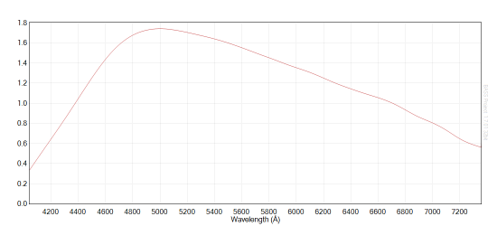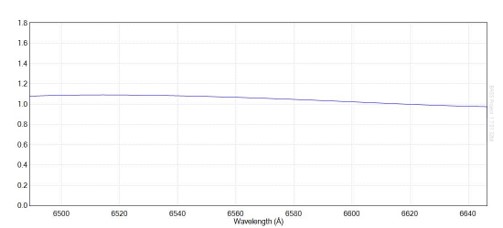Forum Replies Created
-
AuthorPosts
-
 Andy WilsonKeymaster
Andy WilsonKeymasterHi Steve,
I have checked into this. It is either some kind of printing or file preparation anomaly. There is no meaning to the lighter or darker text for different candidates.
Best wishes,
Andy
 Andy WilsonKeymaster
Andy WilsonKeymasterHi Andrew,
The general answer is that the video’s are copyright of the BAA and watching them is considered a benefit of being a member, in the same way as viewing the Journal online. The end of each video has a copyright message. Also note that sharing a link to a video does not allow non-members to watch it. You have to be logged in to see beyond the first 2 minutes.
Of course your own PowerPoint presentation remains yours to do with as you wish.
Best wishes,
Andy
 Andy WilsonKeymaster
Andy WilsonKeymasterHi Tony,
At what point does the video stop? I have done a basic check of the start, middle and end of all 27 presentations, and just did a more detailed check on Mario’s presentation and it looked OK, but I did not rewatch all of it.
Is there a chance you were not logged in, or that your browser did not recognise that you were logged in? If you are not logged in then you can watch the first 2 minutes and then the video stops.
Mario’s email address is at the end of the presentation, so once you can view it then you will have his contact details. If you still have trouble, then it may be worth contacting by email to trouble shoot. We would need to check browser and operating system as it could be some kind of compatibility issue. The videos may not play on older browser and operating systems, though downloading them should get around this problem.
I see you posted your dark skies plea twice. I would usually recommend posting the same message to just a single forum. Otherwise you will need to look at 2 posts to get the whole message and it will knock another post off the top 4 shown on the homepage.
Cheers,
Andy
 Andy WilsonKeymaster
Andy WilsonKeymasterHi Jack,
That is a good point, I think PHD only goes up to 15 second exposure times. I would suggest 5-15 seconds is fine, unless you are trying to guide on a very bright star.
I expect some people guide with shorter exposures, but I doubt there will be anything to be gained from guide exposures shorter than 5 seconds on your setup.
The longer exposures times of course have the benefit that they allow you to guide on fainter stars.
A good way to find out is to experiment. You can take spectra of the same star with guide times varying from 1 second to 15 seconds and see if you spot a decrease in the signal or an increase in noise.
Best wishes,
Andy
 Andy WilsonKeymaster
Andy WilsonKeymasterAt the risk of triggering a major debate, my experience of Windows 10 running my astronomy software and my telescope in my observatory has actually been pretty good. The only software I use that does not simply run is AIP4Win.
Though Windows 10 has the very annoying habit of wanting to run updates every few months without giving the option to postpone or disable updates. I am sure that alone is enough to put many off using it on an observatory computer.
Cheers,
Andy
 Andy WilsonKeymaster
Andy WilsonKeymasterHi Jack,
You have a high quality mount, so as long as it is reasonably well polar aligned you should be able to use exposures of 5 to 30 seconds for guiding, or possibly longer.
I never guide with exposures less than a 5 seconds as otherwise the mount is “chasing the seeing” due to atmospheric turbulence. This is the small scale scintillations that cause a star image to move and change rapidly. Any command sent to move the mount to chase this ‘seeing’ will be too late as by then the atmosphere will have changed and the star moved to a slightly different position. To get around this for spectroscopy would take professional grade adaptive optics, but it is not necessary for the spectroscopy we do.
Best wishes,
Andy
 Andy WilsonKeymaster
Andy WilsonKeymasterHi Martin,
I know a lot of people have experienced difficulty getting AIP4Win to run on Windows 10, me included. Some members have managed to get it working, so they may be able to offer advice. Otherwise I know of 2 alternatives. C-Munipack as mentioned in the above post by James, and AstroImageJ.
Richard Lee has been working on a modification to the BAA VSS Photometry Spreadsheet that is used with AIP4Win, so that it will also accept AstroImageJ files. We are in the final stages of testing the new version of the spreadsheet before releasing it. Richard has written an article on the software in the June 2018 edition of the VSS circular.
http://www.britastro.org/vss/VSSC176.pdf
Would you mind if I retitled this thread to “Photometry Software Issues”? I am thinking this will make it easier to members with similar problems to find it in future.
Cheers,
Andy
 Andy WilsonKeymaster
Andy WilsonKeymasterHi James,
To change your membership type you need to contact the BAA Office, contact details:
https://britastro.org/contact/Contact-the-BAA
In time we wish to have a more streamlined system with our membership database better integrated with the website. For now this kind of change needs to be done by the BAA Office.
Best wishes,
Andy Wilson
BAA Systems Administrator and Web Content Editor
 Andy WilsonKeymaster
Andy WilsonKeymasterHi Jack,
Another important consideration is the field of view. From memory I think you are using a 14″ Celestron or Meade. This will have a long focal length so the field of view in your guide camera will be quite small.
Also, spectrograph guide optics are not that great, though the optics in the updated Lhires III from a few years ago are much better. I think you have one of these models? The point here is I am not sure how wide a usable field of view you get from the guide optics.
The best way to find out would be to try each of the cameras you mention. The Atik 314 will give you a larger field of view, so that can be used to find out if there is a usable wider field than you get in the Lodestar.
The frame rate should not matter. I have never used a frame rate faster than 1 image every 5 seconds for guiding, and up to 30 seconds in a field without a bright star. Anything faster and you risk your mount chasing the seeing rather than guiding. I think you have a good quality mount, so guide exposures of 10’s seconds should not be a problem. So you don’t need the high frame rate from CMOS chips. However, a fast download speed (CMOS or CCD) is an advantage as you can start the next guide exposure quickly.
My personal experience is the Lodestar is very good for guiding. It shows a few hot pixels as it is an uncooled camera, but they’ve never caused me major problems. If replacing the Lodestar with another camera, then as pointed out by Robin you need to be careful that the guide camera is small enough to fit next to your spectrum imaging camera. You might also want to consider the weight depending on the kind of focuser you are using.
Best wishes,
Andy
 Andy WilsonKeymaster
Andy WilsonKeymasterRon Johnson has sent us the following details of Maurice Gavin’s funeral.
It will take place on Tuesday 26th June at Randalls Park Crematorium, Randalls Road, Leatherhead, Surrey, KT22 0AG, at 2.00 pm.
Any flowers should be sent to the undertakers A. & E. Longhurst, Kingston Road, Ewell, KT17 2DX to arrive no later than 10.00 am on 26th June.
Anyone who may wish to attend the gathering after the funeral at a hostelry in Malden Rushett, please let Ron Johnson know by e-mail ronjohnson1781@btinternet.com so that he can let the family know for catering purposes.
 Andy WilsonKeymaster
Andy WilsonKeymasterHi John,
Those are a great set of spectra. I’ve also chased some objects to very low altitude. While you don’t get anything like the quality, you can still get enough photons for some useful data.
To avoid any confusion on the atmospheric response correction, it is not supposed to get rid of the telluric lines. These are the sharp lines and absorption bands due to water and molecular oxygen. They are harder to get rid of, and while there are ways to do it, typically they are left in spectra unless they need to be removed for measurement purposes. They can actually be useful when submitting spectra to databases as they give anyone who then downloads the spectra the ability to redo the wavelength calibration, using the same approach for spectra taken by different observers.
The atmospheric correction removes the continuous transmission/absorption component across the whole spectrum. I could be wrong, but I think this is due to Rayleigh scattering in the Earth’s atmosphere. The same affect that gives the sky its blue colour in daytime and makes the Sun look red when it is near the horizon. When you correct for this in a spectrum, your response correction curve should be very smooth. See the below plots of a low resolution wide wavelength range response correction curve, and a narrow range high resolution curve.


Let me know if you need any pointers on database submission.
Best wishes,
Andy
 Andy WilsonKeymaster
Andy WilsonKeymasterHi John,
Those are good looking spectra. I don’t have a detailed knowledge of Nova spectra, so I am glad to see that Robin has provided some useful information and links.
I suspect your response correction is working reasonably well, but it is difficult to tell how good it is with an evolving spectrum like that of a Nova. A good way to check is to take spectra of a couple of standard stars, like ones with Miles spectra. Use one of them to create the response correction, then apply it to the other star and see how close it is to the Miles spectrum. Noting these are the versions of the Miles spectra which have not been dereddened. You will also need to choose stars and times to give similar altitude when obtaining the spectra, so the effects of the Earth’s atmosphere are similar.
I am glad you found the BASS tutorial useful. I have a feeling I did not include normalising the spectrum to unity over a selected wavelength range that tries to avoid any significant spectral lines. This helps with comparisons and is a standard approach when submitting spectra to a database or campaign. When comparing spectra on a plot I then either overly them or artificially apply an offset in BASS in order to see details and changes.
Great to see you are already getting excellent results from your Alpy.
Best wishes,
Andy
 Andy WilsonKeymaster
Andy WilsonKeymasterHi John,
First of all welcome to the spectroscopy. There can be a steep learning curve at the beginning, but you are on the track and it does get easier. Once you get the hang of it then it is very rewarding, adding a whole new level to the hobby.
I wrote a BAA tutorial on using BASS with the Alpy, which can be accessed here:
https://britastro.org/downloads/10412
In section 5 on page 23 I go through calibration, covering off many of the things you have found, like a cubic fit being a good compromise. I think the strength of lines can vary from calibration lamp to calibration lamp. In the tutorial I include plots/images of calibration lamps with the lines identified from 3 different sources, which may help in the identification. I found the following 6 lines worked well, though you may find a different set works best for you.
4200.67 Ar
4764.87 Ar
5852.49 Ne
6562.85 Hα
6965.43 Ar
7272.94 ArBASS is very user friendly and easy to get going with, while ISIS is great at processing spectra quickly with less intervention but it has a steeper learning curve and you have to get everything setup just right. There is also DEMETRA from Shelyak, which I have not used but I understand it was created for the Alpy and should also make processing spectra more straight forward.
Best wishes,
Andy
 Andy WilsonKeymaster
Andy WilsonKeymasterInteresting question.
I agree, a lot of units in astronomy are a bit crazy, but I do find arcseconds are a very useful size. They are close in size to typical seeing conditions, and a small number can be used to describe the size of planets and many other celestial objects.
Arcseconds are also quite handy when dealing with distances measured by parallax, like by the Gaia mission, as they are used to define the distance in parsecs. The distance in parsecs is defined as one divided by the parallax in arcseconds.
Cheers,
Andy
 Andy WilsonKeymaster
Andy WilsonKeymasterVery exciting times Alex. The data will revolutionise many fields of astronomy. I was just starting to use the data to analyse star forming regions when an unfortunately timed computer failure stopped me.
Andy
 Andy WilsonKeymaster
Andy WilsonKeymasterThe online resources of SIMBAD and Aladin can be very useful for investigations.
http://simbad.u-strasbg.fr/simbad/
http://aladin.u-strasbg.fr/aladin.gml
Here is M108 in Aladin Lite displaying an SDSS9 image with 2MASS point sources:
Cheers,
Andy
 Andy WilsonKeymaster
Andy WilsonKeymasterHi Roger,
I must admit to being pleasantly surprised by the number of BAA members already involved with exoplanet observations. So I agree this does appear to be the right time for a new Section.
Best wishes,
Andy
 Andy WilsonKeymaster
Andy WilsonKeymasterHi Adam,
On this ocassion I think it is a foreground star. I’ve found some old images which show the bright star at that position.
http://www.astrocruise.com/galaxies/m108.htm
http://www.astrosurf.com/jwisn/m108.htm
Though this bright star near the centre is not always so obvious as can be seen from Graham Winstanley’s image.
https://britastro.org/node/10192
It might be that it is a variable star, or possibly a very red star that shows up more prominently in some images than others depending on filters and equipment sensitivity. I’ve tried to identify the star to confirm its nature, but no luck.
Good call though as it is always a good idea to check images for the unexpected.
Cheers,
Andy
 Andy WilsonKeymaster
Andy WilsonKeymasterHi Roger,
That is an interesting idea. It also occurs to me whether exoplanets might be a good fit within the Variable Star Section? I’m not sure if this is a controversial idea, perhaps as a ‘subsection’? I suggest this as the techniques are the same, since exoplanets are detected via their influence on their host star, causing it to vary in magnitude or radial velocity. As I understand it, amateurs have been able to detect previously discovered exoplanets via both the transit and radial velocity methods, though I think only a handful are within reach of amateur equipment. If there is a new Section, then I think it would be good to have close ties with the Variable Star Section.
Perhaps there are members who have or are actively making observations of exoplanets who could make their views known? Though you may have been in touch with these members.
It is a topic that captures the imagination, so I can see the benefits of the BAA establishing some kind of presence.
Best wishes,
Andy Andy WilsonKeymaster
Andy WilsonKeymasterGood spot Robin. I’ve edited the link so the full stop is not part of it. I’m sure David won’t mind.
Andy
BAA Web Content Editor
-
AuthorPosts
